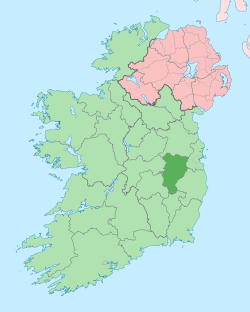River Boyne
The River Boyne (Irish: An Bhóinn or Abhainn na Bóinne) is a river in Leinster, Ireland, the course of which is about 112 kilometres (70 mi) long. It rises at Trinity Well, Newberry Hall, near Carbury, County Kildare, and flows towards the Northeast through County Meath to reach the Irish Sea between Mornington, County Meath, and Baltray, County Louth.
| River Boyne | |
|---|---|
River Boyne at Brú na Bóinne. | |
| Etymology | Proto-Celtic *bouwinda, "white cow" |
| Native name | An Bhóinn (Irish) |
| Location | |
| Country | Republic of Ireland |
| Region | Leinster |
| Counties | County Kildare, County Offaly, County Meath, County Louth |
| Physical characteristics | |
| Source | Trinity Well, Newberry Hall, near Carbury |
| • location | County Kildare |
| Mouth | Irish Sea |
• location | Between Mornington, County Meath and Baltray, County Louth |
• coordinates | 53.72173°N 6.23813°W |
| Length | 112 km (70 mi) |
| Basin size | 2,695 km2 (1,041 sq mi) |
| Discharge | |
| • average | 38.8 m3/s (1,370 cu ft/s) |
| Basin features | |
| Tributaries | |
| • right | River Blackwater |
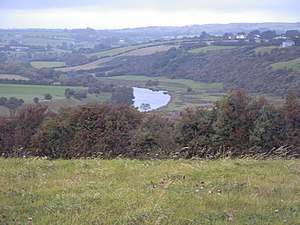
Salmon and trout can be caught in the river, which is surrounded by the Boyne Valley. It is crossed just west of Drogheda by the Boyne River Bridge, which carries the M1 motorway, and by the Boyne Viaduct, which carries the Dublin-Belfast railway line to the east. The catchment area of the River Boyne is 2,695 km2.[1] The long term average flow rate of the River Boyne is 38.8 cubic metres (50.7 cu yd) per second.[1]
Despite its short course, the Boyne has historical, archaeological and mythical connotations. The Battle of the Boyne, a major battle in Irish history, took place along the Boyne near Drogheda in 1690 during the Williamite war in Ireland. It passes through the ancient town of Trim, Trim Castle, the Hill of Tara (the ancient capital of the High King of Ireland), Navan, the Hill of Slane, Brú na Bóinne (a complex of megalithic monuments), Mellifont Abbey, and the medieval town of Drogheda. In the Boyne Valley can also be found other historical and archaeological monuments, including Loughcrew, Kells, Celtic crosses, and castles.
This river has been known since ancient times. The Greek geographer Ptolemy drew a map of Ireland in the 2nd century which included the Boyne,[2] which he called Βουουινδα (Bouwinda) or Βουβινδα (Boubinda). During the High Middle Ages, Giraldus Cambrensis called it the Boandus. In Irish mythology it is said that the river was created by the goddess Boann and Boyne is an anglicised form of the name.[2] In other legends, it was in this river where Fionn mac Cumhail captured Fiontán, the Salmon of Knowledge. The Meath section of the Boyne was also known as Smior Fionn Feidhlimthe[3] (the 'marrow of Fionn Feilim'). The tidal estuary of the Boyne, which extends inland as far as the confluence with the Mattock River, 'the curly hole', had a number of names in Irish literature and was associated as a place of departure and arrival in the ancient legends and myths, such as The Tragedy of the Sons of Tuireann, Togail Bruidne Dá Derga, &c. In the Acallam na Senórach the estuary has the name Inber Bic Loingsigh, abounding in ships. Inber Colpa or Inber Colptha was the principal name for the mouth of the Boyne in early medieval times. The townlands and civil parish of Colp, or Colpe on its southern shore preserve the name. It was associated in myth with Colpa of the Sword, a son of Míl Espáine, in the Milesian origin of the Irish, who drowned in the attempt to land there and is by tradition buried in the ringfort behind Colpe church. An alternative Dindsenchas tradition associates the name with the Máta, a massive aquatic creature, which having been killed was dismembered at Brú na Bóinne was thrown in the Boyne. Its shinbone (colptha) reached the estuary giving name to Inber Colptha.
Boyne Canal

The Boyne Navigation is a series of canals running roughly parallel to the main river from Oldbridge near Drogheda to Navan. Owned by An Taisce and mostly derelict, the Inland Waterways Association of Ireland are restoring the navigation to navigable status. The canal at Oldbridge which runs through the battle of the Boyne Site was the first to be restored.
Prehistoric art
A rock with indications of being Prehistoric art was found in August 2013. Cliadh O’Gibne reported through the Archaeological Survey of Ireland that a boulder with geometric carvings had been found in Donore, County Meath.[4]
Ancient log-boat
The Boyne Fishermen's Rescue and Recovery Service (BFRRS), near Drogheda, County Louth, were doing one of their regular operations to remove shopping trolleys from the Boyne, in May 2013, when they discovered an ancient log boat, which experts believe may be 5000 years old. Initial examination by an underwater archaeologist, suggests it could be very rare because, unlike other log-boats found here, it has oval shapes on the upper edge which could have held oars. Investigations were on-going as of 2013.[5]
Viking ship
In 2006, the remains of a Viking ship were found in the river bed in Drogheda during dredging operations. The vessel is to be excavated as it poses a hazard to navigation.[6]
Annalistic references
- AI770.2 The battle of Bolg Bóinne [gained] against the Uí Néill, by the Laigin.
Gallery
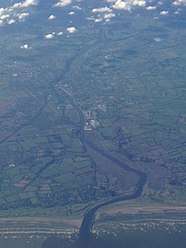 Aerial view of the River Boyne estuary and Drogheda.
Aerial view of the River Boyne estuary and Drogheda.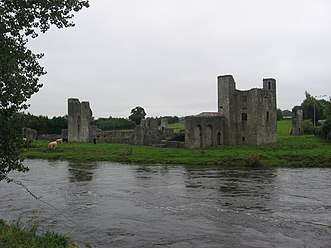 River Boyne at Trim.
River Boyne at Trim. River Boyne at Navan.
River Boyne at Navan. Weir on Boyne near Stackallen
Weir on Boyne near Stackallen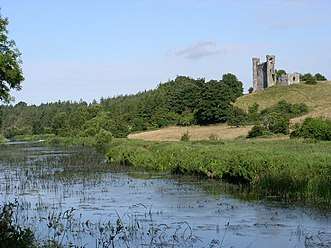 River Boyne at Dunmoe Castle.
River Boyne at Dunmoe Castle. River Boyne upstream from Slane.
River Boyne upstream from Slane. River Boyne passing under the Boyne Cable Bridge in Drogheda.
River Boyne passing under the Boyne Cable Bridge in Drogheda.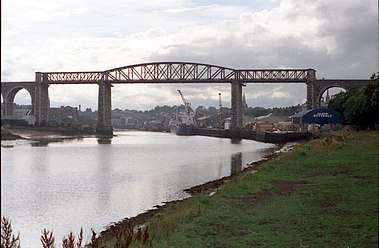 Boyne Viaduct over the River Boyne.
Boyne Viaduct over the River Boyne. River Boyne at Mornington.
River Boyne at Mornington._-_Glebe%2C_County_Meath%2C_Ireland_-_August_8%2C_2017_-_01.jpg) River Boyne at Brú na Bóinne.
River Boyne at Brú na Bóinne._-_Glebe%2C_County_Meath%2C_Ireland_-_August_8%2C_2017.jpg) River Boyne at Brú na Bóinne.
River Boyne at Brú na Bóinne.
See also
References
- South Eastern River Basin District Management System. Page 38 Archived 2016-03-03 at the Wayback Machine
- Holten, Anthony (2016). The River Boyne Hidden Legacies, histories and lore explored on foot and by boat. Ireland. pp. 27–29. ISBN 978-0-9569911-2-6.
- Dineen: Foclóir Gaedhilge agus Béarla, 1927 ("Smior" - pg 1067, Ed.1996)
- "Newly Discovered Prehistoric Art in the Boyne Valley". National Monuments Service. Retrieved 30 November 2013.
- "Log Boat Found in Ireland's Boyne River". Archaeology. Archaeological Institute of America. 13 May 2013. Retrieved 2 June 2017.
- Viking ship found in Boyne to be excavated
External links
| Wikisource has the text of the 1911 Encyclopædia Britannica article Boyne. |
